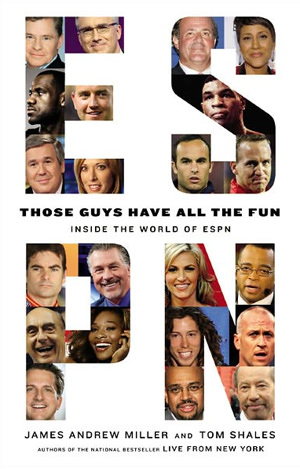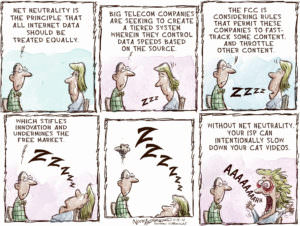An Oral History of ESPN
The book lacks a narrative voice to set the scene, pull the reader along. Authors are not just tape recorders with expense accounts. They need to analyze, criticize, validate their characters. Here, they're often missing in action.About $4 of your monthly cable bill goes to ESPN, even if you never watch it.
This review is from a syndication service of The Washington Post.
“SportsCenter,” ESPN’s popular highlights show, is introduced by theme music that ends with six staccato notes: “dah-dah-dah, dah-dah-dah.” When some genius tried to replace the theme a few years ago, the switchboard ignited. “How dare you!” was a common complaint. One mother said of the new music: “My son can’t fall asleep to that! He needs dah-dah-dah, dah-dah-dah!”
That’s how thoroughly ESPN has soaked through American culture. Fans in every stadium hold up signs saying “SportsCenter is Next!” Shows such as “College GameDay” and “Monday Night Football” are must-see viewing for millions. President Obama fills out his college basketball bracket watched by cameras from a media powerhouse that airs 70,000 hours of programming a year on eight different networks. About $4 of your monthly cable bill goes to ESPN, even if you never watch it.
So yes, ESPN is a big deal, and it is worth a big book. But this big? As former host Max Kellerman candidly admits, “The fact is, it’s a trivial subject.” Not only that, the authors of “Those Guys Have All the Fun” (James Andrew Miller is a journalist and TV producer, Tom Shales is a former TV critic for The Washington Post) have bloated the text with obvious and repetitive observations. On page 607, football analyst Mike Tirico intones, “People come to the game for the game itself.” Sixty-nine pages later he says, “But to me, you come to the football game for the football game.” Really?
This is essentially an oral history, with the authors contributing occasional commentary. So the book lacks a narrative voice to set the scene, describe the characters, pull the reader along. Authors are not just tape recorders with expense accounts. They need to analyze, criticize, validate their characters. Here, they’re often missing in action.
Those Guys Have All the Fun: Inside the World of ESPN
By James Andrew Miller, Tom Shales
Little, Brown and Company, 784 pages
Still, they tell a lot of good stories. I laughed out loud when a football player tried to evade a drug test by substituting a friend’s urine. The friend was a woman, and the test came back saying he was pregnant.
More compelling is the tale of how ESPN got started. In the late ’70s, a father and son team, Bill and Scott Rasmussen, wanted to broadcast news about Connecticut sports. They soon learned that by using a dandy new technology — satellites — they could reach the whole country at little added cost. Their second big insight was that they could charge cable companies a fee for carrying their channel. Above all, they sensed the huge market for in-depth information about sports. “We sold male eyeballs to advertisers,” says marketing director Judy Fearing. No wonder the network’s first big advertiser was Budweiser.
If guys watched ESPN, they also ran it, and that caused big problems. The Rasmussens located the business in Bristol, a remote Connecticut town where their employees had little to do except work long hours, drink heavily, smoke dope and chase any woman who came within range. Karie Ross, a courageous young reporter who publicly criticized her bosses (and then lost her job) says, “I don’t think a lot of these men knew what they were doing was illegal, but they should have known that using the influence of their position to date or get sexual favors from these girls underneath them — who had no power whatsoever — was not right.”
ESPN has tried to upgrade its policies on gender equality. Two baseball analysts were recently fired for mistreating subordinates, and last September “SportsCenter” was hosted entirely by women in consecutive time slots. The larger question is whether “the little corner store that has grown into an empire” can upgrade, or even maintain, its stature in a rapidly changing technical universe. Satellites long ago gave way to high-speed Internet connections. I’m an avid sports fan, but I haven’t watched “SportsCenter” or “Baseball Tonight” in years; I just go to my computer and dial up the highlights I want to see, when I want to see them. In the future, how many babies will need “dah-dah-dah, dah-dah-dah” to go to sleep?
Steven V. Roberts teaches journalism and politics at George Washington University. His latest book, “Our Haggadah,” written with wife Cokie Roberts, appeared this spring.
(c) 2011, Washington Post Book World Service/Washington Post Writers Group
Your support matters…Independent journalism is under threat and overshadowed by heavily funded mainstream media.
You can help level the playing field. Become a member.
Your tax-deductible contribution keeps us digging beneath the headlines to give you thought-provoking, investigative reporting and analysis that unearths what's really happening- without compromise.
Give today to support our courageous, independent journalists.





You need to be a supporter to comment.
There are currently no responses to this article.
Be the first to respond.